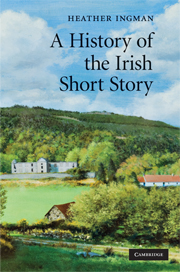Book contents
- Frontmatter
- Contents
- Acknowledgments
- 1 Introduction
- 2 The nineteenth century: nation and short story in the making
- 3 Fin de siècle visions: Irish short fiction at the turn of the century
- 4 The modern Irish short story: Moore and Joyce
- 5 1920–1939: years of transition
- 6 1940–1959: isolation
- 7 1960–1979: time, memory and imagination
- 8 1980 to the present: changing identities
- Notes
- Biographic glossary
- Bibliographic essay
- Index
5 - 1920–1939: years of transition
Readings: Frank O’Connor and Norah Hoult
Published online by Cambridge University Press: 04 August 2010
- Frontmatter
- Contents
- Acknowledgments
- 1 Introduction
- 2 The nineteenth century: nation and short story in the making
- 3 Fin de siècle visions: Irish short fiction at the turn of the century
- 4 The modern Irish short story: Moore and Joyce
- 5 1920–1939: years of transition
- 6 1940–1959: isolation
- 7 1960–1979: time, memory and imagination
- 8 1980 to the present: changing identities
- Notes
- Biographic glossary
- Bibliographic essay
- Index
Summary
‘They pay for politics in this country but they refuse to pay for literature,’ complained Liam O'Flaherty in a letter of 14 March 1924 to his editor, Edward Garnett. ‘Literature is a poor trade in Ireland,’ Lennox Robinson remarked in the first volume of the newly established magazine, The Irish Statesman, ‘and it is difficult to think of any man or woman over here who lives entirely by writing.’ In The Irish Times, 1932, Brinsley MacNamara summed up this period succinctly: ‘The outlook for literature in Ireland at the beginning of the Free State was not so promising as it had been ten or even twenty years earlier.’ The years of fighting ending in partition of the country, a stagnant economy, the decline of the Irish language and a repressive religious ethos were just some of the factors that contributed to shape the depressed cultural, economic and social climate of post-revolutionary Ireland, so prominent a theme in the Irish short story of the 1920s and 1930s.
One attempt to keep the literary torch alight in the exhausted years following the war of independence and the civil war was The Dublin Magazine, founded in 1923 and edited by Seumas O'Sullivan until his death in 1958. In defiance of Ireland's stultifying post-revolutionary cultural climate, O'Sullivan proclaimed his aim of ‘making a definite and practical effort towards reawakening in Ireland the unifying spirit of art, towards fostering the creative side of the national individuality in order that the country may gain the power of expressing her nobler values in the world’.
- Type
- Chapter
- Information
- A History of the Irish Short Story , pp. 113 - 150Publisher: Cambridge University PressPrint publication year: 2009

